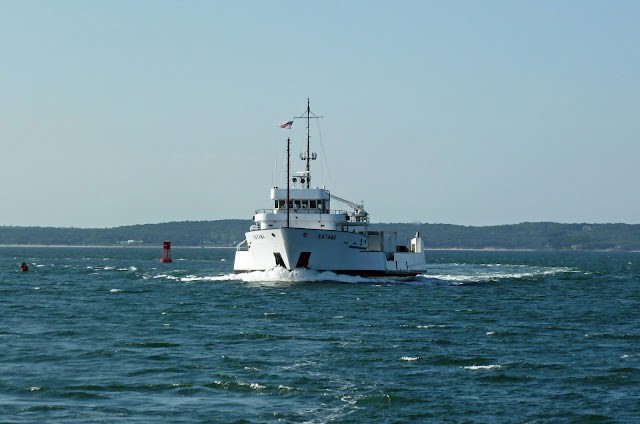Cuttyhunk
First stop in Massachusetts was the harbor at Cuttyhunk, the end of the chain of islands off the west end of Cape Cod. There are 16 Elizabeth Islands. Fourteen are owned by the Forbes family, one is a wildlife refuge, and the last is Cuttyhunk.
It is a quaint community, with 18 year-round residents and a summer population of up to 300. The island is an incorporated town, with its own government.
As is custom with New England churches along the water, the Cuttyhunk church has a wind vane on the steeple. Appropriately, for an island that was once a fishing camp, and still has a fishing industry, the wind vane indicator is a fish.
 |
| Lynda Krueger photo |
Martha's Vineyard
Gay Head, Martha's Vineyard. Now called the Aquinnah Light, this lighthouse has alternating red and white flashes. Although Martha's Vineyard is a tourist destination, with the requisite loud bars and t-shirt shops, there is much natural beauty remaining. Gay Head Point is one.
Traveling across the sound from Cuttyhunk involves heavy ferry traffic. Ferries come from multiple ports to bring visitors to the island.
In the 1830's, the Methodist Church set up a conference center on the island. Interesting houses, with pointed windows, as in some churches, were built around the center, creating a quaint community.
Other areas of Martha's Vineyard have some grand homes.
And, there are beaches to comb . . .
and critters to watch.
Woods Hole
There is a pass between the mainland of Cape Cod and the Elizabeth Islands, called Woods Hole. It has some fast currents making passage difficult. Having ferries squeezing through at the same time makes it even more interesting.
Getting through Woods Hole with the proper current puts the boat up Buzzards Bay and into the Cape Cod Canal with the wrong current. So, a stop in the nearby Quissett Harbor was made to time the currents. It is a protected harbor, filled with racing dinghies.
A good stop it was. The spit between the harbor and Buzzards Bay was a park with a nice beach. More beachcombing opportunities.
Onset
At the head of Buzzards Bay and the south end of the Cape Cod Canal, lies the small town of Onset. This was the far end of the journey for Erika Lin. The town has a few moorings that the crews were able to snag for an evening,.
Onset provided an opportunity for a Great Loop Rendezvous. Joe and Pat Apicella completed the Loop on a Maninship 40, Glory Days, often crossing paths with Erika Lin and Last Dance.
Leaving in the morning with a favorable current, Last Dance was fortunate to make it through the railroad bridge just before it closed.
Having to wait for the bridge would not only be a delay, but would require running in the opposite direction just to remain in place since the current was running over 3 knots.
Newburyport
The downtown of Newburyport is alive with thriving businesses and a definite lack of tourist traps. They have a town dock and moorings to encourage visitors by boat. Located on a river that has current reaching 6 or 7 knots and an inlet so rough that the Coast Guard has installed a large stop light to indicate when the inlet is too rough to be used, they need to add some encouragement.
The town is filled with interesting architecture, including a church that has been converted to a restaurant.
Much interesting architecture has been preserved in Newburyport. This Institution for Savings Building still houses the original tenant.
It is a great town for the crew to walk and meet new friends. The streets are always filled with people and there is a large, well-used park at the town dock. The Bull Mastif/St. Bernard/Hound dog's person suggested an Italian restaurant, Enzo.
One way to sample the regional cultures of the country is through food. Enzo is an Italian restaurant that does not have red sauces and blends local foods into their recipes. Lobster over fresh home-made pasta and littleneck clams on spaghetti were delicious.
Enzo's special dessert of the night was fresh strawberries marinated in a strawberry sauce over meringue with whipped cream and strawberry ice cream. It was amazingly full of flavor. Exploring can be very enjoyable.































































